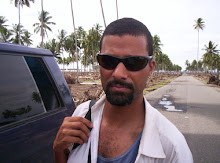 Could this landslide from the continental slope offshore Oregon generate a tsunami?
Could this landslide from the continental slope offshore Oregon generate a tsunami?The answer is simple. Maybe...
It depends on several factors. First off, is it big enough? Tsunamis are generated by rapide movements in lots of water, be it from earthquakes, asteroids, volcanoes or landslides. A pebble thrown into the ocean is certainly no asteroid.
And while even a small event can generate a very small tsunami, it depends on the location of whatever it was that moved the water as to whether the tsunami will be noticed or not. Landslides, volcanoes and even asteroids are "point-sources", while and earthquake moves a very large area of seafloor (hence a lot of water). Waves generated by point source attenuate or decay much faster than those generated by a lifting up a vast area of seafloor. In other words, it is very difficult for a tsunami generated by a landslide, volcano, or asteroid to make it all the way across an ocean.
Yet another complication, as with many things, is timing. Most very large tsunamis are very old- in nature, big events tend to happen infrequently. Should very large offshore landslides occur as frequently as large-magnitude earthquakes, the continental slope would quickly eat its way onto land! So, while technology has allowed us to image all sorts of amazing landslides on the world's continental slopes, many of which appear very young, they tend to be old, and pose little danger to communities on shore.
(One might ask then, when do they occur? Most offshore landslides occur either during sea level lowstands or during times of changing sea level. During glacial periods, sea level is lower, and rivers dump heaps of sediment directly on the continental slope, providing fuel for landslides. During highstands, like now, sediment is sequestered in estuaries and in foreland basins on the continental shelf. If earthquakes trigger landslides, then the hypothetical first earthquake after a sea level lowstand would shed all the sediment off, leaving nothing left to fail! But, this is just a digression by this marine geologist....)
Perhaps the last unconstrained variable (i.e. something we have no idea of!) is once a landslide begins, how fast does it actually fail? Most models that predict tsunamis assume that the landslides are frictionless- that is, once they get going, there is nothing slowing them down. This isn't likely the case, but nonetheless, landslides occur offshore, and they generate tsunamis.
There are two clear examples of offshore landslides that have generated tsunami. The first (that I know of) was 7,200 years ago offshore Norway called Storegga. Following the last sea level lowstand, glaciers provided sediment to the continental slope, and as the land rebounded from having the weight of the glaciers released, earthquakes fired off, shaking loose the sediment. The failure generated a tsunami that laid a deposit in many places surrounding Norway, including underneath the greens at the famous golf course at St. Andrews.
The second example was much more recent- in 1929 a magnitude 7.2 earthquake triggered a landslide offshore Newfoundland, Canada in the Grand Banks. We know there was a landslide because it severed submarine communication cables going between North American and England. Not long after the earthquake, a 7.5 m tsunami hit Newfoundland's Burin Peninsula, killing 28 people in Canada's worst earthquake-related disaster.
So, the most important thing we can do to plan for landslide generated tsunami is to constrain the properties that trigger landslides. What is the strength of the sediment in question? Has there been landslides in this region in the past? What is the frequency and magnitude of earthquakes in the region? Is there a weak layer that might provide a sliding surface for a failure?
To address these questions, geotechnical engineers, geologists, geophysicists and seismologists must come together to address this complicated, technical question. Not one of these scientists can address this working in a vacuum, nor does any one of these possess the necessary knowledge and skills to really be effective. Yet a community working together, making the necessary data and information freely available, can make advances towards protecting life and property in leaps and bounds. A kind of scientific open-sourcing.

No comments:
Post a Comment